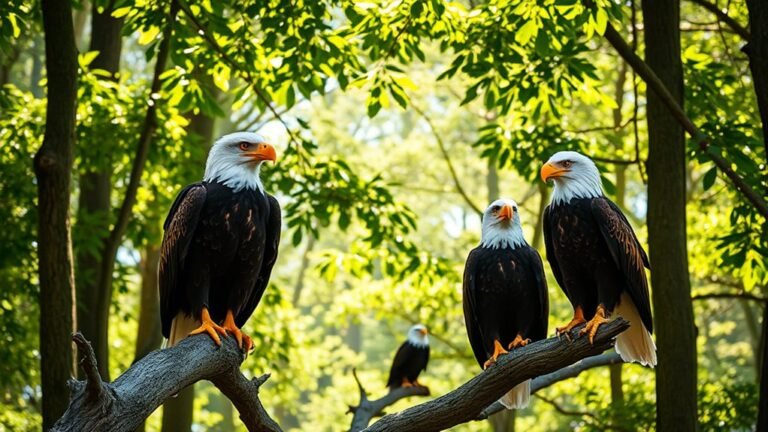Bird That Looks Like an Eagle: Majestic Raptor Look-Alikes
When you look at the sky, you may see birds that remind you of eagles. One example is the Ferruginous Hawk. This bird has a strong body and beautiful colors that resemble raptors. Buzzards also have a graceful shape as they hunt for food. These birds display both strength and beauty. What makes these birds different from true eagles? Let's examine the unique features that define these impressive birds.
Key Takeaways
Many birds of prey, like hawks and kites, share features with eagles. They have broad wings and sharp beaks. The Black Kite is agile and can often be seen soaring in areas where eagles hunt. The Tawny Eagle shows off brown and gold feathers. It flies and hunts like larger eagles. The Booted Eagle uses impressive aerial skills and has physical traits similar to various eagle types. Other raptors, such as certain hawks, have strong hunting skills and sharp vision, similar to eagle traits. These similarities highlight the beauty and power of these majestic birds.
The Golden Eagle: A True Raptor Icon

The Golden Eagle is a powerful symbol of raptors. Its wingspan is impressive, and its eyesight is sharp, making it an exceptional hunter. When you watch it, you can see how it soars effortlessly, searching wide areas for food.
This remarkable bird is important for its environment, but it faces threats like habitat loss and climate change. Conservation efforts for Golden Eagles are crucial. By helping to protect their habitats and learning about their habits, you aid in ensuring their survival.
Supporting these efforts connects you to a larger ecological community and helps future generations witness the beauty of this noble bird in nature.
The Bonelli's Eagle: A Powerful Hunter
Bonelli's Eagle is a powerful hunter known for its striking plumage and fierce nature.
With a large wingspan and sharp talons, this raptor hunts effectively in its natural habitats, which include rocky plateaus and open woodlands.
Bonelli's Eagle patrols these areas, using its keen eyesight to scan for prey from high above. When it spots a target, it dives with precision.
This eagle primarily hunts medium-sized mammals and birds, showcasing its adaptability to different environments.
Each swoop and glide demonstrates Bonelli's Eagle's skill as a hunter.
Its presence reminds us of nature's balance and the need to protect its habitat for future generations.
The Harpy Eagle: The World's Most Powerful Bird of Prey

Harpy Eagles are recognized as some of the strongest birds of prey. Their powerful bodies and large wings allow them to fly skillfully in dense forests. They primarily live in Central and South America, where the rich canopies provide excellent hunting grounds.
These eagles hunt monkeys and sloths, showcasing impressive skills. Their unique features, like a noticeable crest and strong talons, make them top predators in their habitat.
As you learn more about them, you'll see how they fit into their ecosystems, creating a strong bond with the nature around them.
The Black Kite: Agile and Adaptable
Black Kites fly gracefully in the sky. They show great agility and adaptability. You can see them move easily in different habitats, such as cities and open fields. They're skilled in finding food. They often hover above potential meals and pick up leftovers with their sharp talons.
Black Kites often gather in loose groups, creating a sense of community that helps them survive. Whether they fly over a bustling city or glide near rivers, they demonstrate resilience.
Their ability to thrive in different environments makes them an interesting subject for study. The presence of Black Kites reminds us of nature's adaptability and cleverness.
They connect with bird enthusiasts, creating a shared appreciation for these fascinating birds.
The White-tailed Eagle: A Magnificent Scavenger

The White-tailed Eagle is a remarkable scavenger found along coastlines and wetlands. This eagle has a strong body and large wings, which allow it to glide gracefully through the air.
It plays a key role in its ecosystem by eating carrion, which helps keep the environment balanced. You can spot the White-tailed Eagle in various habitats, such as coastal cliffs and lakeshores.
Conservation efforts are vital for protecting the White-tailed Eagle and its nesting areas. By supporting projects that safeguard their habitats, you can help ensure the survival of these beautiful birds.
Join a community of enthusiasts to appreciate and protect the White-tailed Eagle, allowing it to thrive in its natural surroundings.
The African Fish Eagle: The Voice of the Waters
The African Fish Eagle is a vital part of Africa's river ecosystems. Its striking plumage stands out against the blue waters.
This elegant bird flies with ease, representing the healthy habitats it inhabits. Its distinctive call fills the air, highlighting the balance of nature.
As it hunts fish, the Eagle supports the health of aquatic environments. Watching an African Fish Eagle in the wild offers a glimpse into the survival and connections between species.
These raptors play an important role in protecting Africa's unique wildlife.
The Steppe Eagle: Masters of Migration
The Steppe Eagle is a remarkable bird known for its ability to migrate. It travels great distances as the seasons change, adapting well to its surroundings.
These eagles prefer open grasslands, steppe areas, and vast plains, which provide plenty of food.
Here are key facts about the Steppe Eagle:
- It uses thermals to soar efficiently.
- It looks for habitats with various prey options.
- It shows great endurance during its migrations.
- It has strong resilience to climate changes.
The Steppe Eagle isn't just impressive for its physical traits but also for its instinctual ability to thrive as it moves across different regions.
The Lesser Spotted Eagle: A Stealthy Predator
The Lesser Spotted Eagle is a skilled predator known for its stealth. This bird is less flashy than other eagles, yet it possesses a quiet elegance.
It glides silently over fields and forests, using its sharp eyesight to spot small mammals and birds below. Its hunting method is unique; it often hides and then swoops down quickly to catch its prey.
This approach shows its patience and skill, making each hunt effective. Watching this eagle hunt is like seeing a graceful performance as it moves through its environment.
Its ability to remain hidden adds to the allure of the Lesser Spotted Eagle in the raptor community.
The Osprey: Expert Fisher of the Skies
The Osprey is a highly skilled bird known for its fishing abilities. It dives into water with high precision to catch fish. You can often see it flying above, looking for movement in the water.
During osprey migration, these birds travel long distances to find food, making them a captivating sight.
Key features of the Osprey include:
- Talons: Ospreys have special toes that help them hold onto slippery fish.
- Nests: They build large nests near water and often reuse them over the years.
- Calls: They make unique sounds that reflect the excitement of catching prey.
- Adaptability: Ospreys live in various habitats and show strong resilience in different environments.
Watching an Osprey in action is a truly inspiring experience.
The Red Kite: Graceful and Gorgeous
The Red Kite is an elegant bird with a wingspan of nearly six feet. It glides effortlessly in the sky, captivating those who watch. Its tail feathers form a distinctive fork, which adds to its striking appearance.
This bird is known for its intelligence, often scavenging for food instead of hunting. The conservation efforts have successfully increased its population across Europe, bringing together nature lovers and local communities who appreciate this beautiful bird.
Observing these kites in flight creates a connection to nature. Their acrobatic movements remind us of the importance of protecting our natural world.
The Crested Serpent Eagle: A Unique Hunter
The Crested Serpent Eagle is a unique bird of prey that stands out for its striking appearance and hunting abilities. This raptor is often found in forests and open areas in Southeast Asia.
Here are some key features of the Crested Serpent Eagle:
- It has a distinctive crest that adds to its majestic look.
- Its sharp eyesight allows it to see snakes from a distance.
- It typically hunts in the early morning or late afternoon.
- It prefers habitats that include both forested areas and open spaces, enhancing its stealth during hunts.
The Crested Serpent Eagle combines grace with deadly accuracy, making it a remarkable predator among raptors.
Observing its hunting techniques is an exciting experience for nature enthusiasts.
The Tawny Eagle: A Robust Presence
The Tawny Eagle is a strong presence in the sky. This bird adapts well in various environments. You can find Tawny Eagles often flying over open areas, like grasslands and farms.
Their feathers, which are shades of brown and gold, help them blend into their surroundings. With sharp eyesight, they can spot prey from far away.
These eagles use interesting hunting methods. They can soar high and then dive quickly to catch small animals or birds.
Sometimes, you may see Tawny Eagles roosting together, showing their social nature. Their power and ability to thrive in different settings make them unique in the bird world.
The Booted Eagle: Small Yet Mighty
The Booted Eagle is a fascinating bird known for its agility and hunting skills. It lives in open areas like grasslands and sparse forests. This small raptor displays many interesting behaviors that show how well it adapts to its environment.
Here are some key features of the Booted Eagle:
- Excellent flyer: It moves quickly and performs impressive aerial tricks.
- Varied diet: It hunts small mammals, birds, and reptiles.
- Nesting preferences: It builds secure nests in tall trees and on cliffs.
- Territorial behavior: Males show off in the sky to assert their territory.
Watching the Booted Eagle in its natural habitat deepens your appreciation for nature and highlights that strength and skill can come in small sizes.
Frequently Asked Questions
How Do I Identify an Eagle Versus Other Birds of Prey?
To identify eagles, first compare their size to other birds of prey. Eagles are typically larger. Look for bold feather patterns. Eagles often have unique markings that stand out. Observing these traits will improve your birdwatching and help you enjoy nature more.
What Is the Lifespan of the Average Eagle Species?
Eagles typically live 20 to 30 years in the wild. Knowing how long these birds can live helps us appreciate their strength and importance in nature. This understanding can deepen your connection to these magnificent animals that gracefully soar in the sky.
Are Eagles Endangered or Threatened Globally?
Many eagle species face threats to their populations around the world. Factors such as habitat loss, pollution, hunting, and climate change make them more vulnerable. This situation highlights the need for increased awareness and conservation efforts to protect these magnificent birds.
What Habitats Do Various Eagle Species Prefer?
Eagles prefer different habitats depending on their species. They often choose open landscapes, wooded areas, and wetlands. Recognizing these preferences helps us understand where eagles live and the important roles they play in their environments. Each habitat provides unique resources that support their feeding, nesting, and hunting needs.
How Do Eagles Communicate With Each Other?
Eagles communicate using vocal displays and social interactions. Their calls indicate territory, attract mates, or signal danger. By observing these behaviors, we can see the strong bonds and hierarchy within their social structures. Eagles showcase their communication skills in many ways, making them intriguing creatures to study and understand.

Ava is a bird enthusiast and nature lover who has spent countless hours observing and learning about the fascinating world of birds. With a passion for sharing her knowledge and inspiring others to appreciate the beauty of birds, Ava writes about her experiences and insights on avianadmirer.com.







